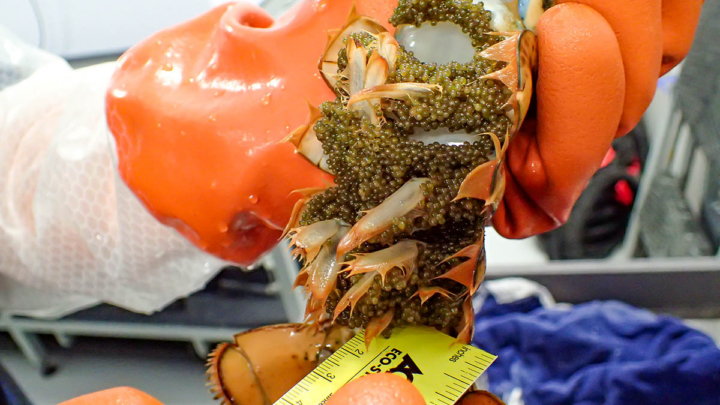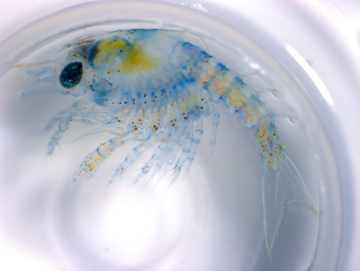Warming oceans may pose a serious threat to American lobsters
The following story originally appeared on the website W&M’s Batten School & VIMS. – Ed.
The Gulf of Maine is warming faster than 99% of the world’s oceans, raising concerns for its $2 billion-a-year American lobster fishery. Scientists at William & Mary’s Batten School & VIMS have been studying the impacts of ocean acidification and warming on lobster reproduction, and the results of their most recent research suggest the rising temperatures pose the greatest risk.
Utilizing a purpose-built experimental facility designed by Professor Emily Rivest and housed in the Batten School of Coastal & Marine Sciences & VIMS’ Seawater Research Laboratory, the researchers exposed egg-bearing lobsters from the Gulf of Maine to water temperature and pH conditions that mimic those predicted for 2060. Published in the journal Marine Ecology Progress Series, the results revealed that the embryos can handle ocean acidification surprisingly well, but increased temperatures led to distinct stress responses that ultimately resulted in smaller larvae.
“American lobsters are dynamic creatures that have been shown to tolerate highly variable conditions as they move from coastal waters to the deeper ocean,” said the study’s lead author Brittany Jellison, who conducted the research as a postdoctoral scholar at the Batten School & VIMS. “However, as we observe rising ocean temperatures, increased acidification and more frequent marine heat waves, it’s important to understand how future environmental changes might impact this economically and culturally important species.”
Turning up the heat

Supported by a National Sea Grant American Lobster Initiative grant awarded to Rivest and Professor Jeffrey Shields, the study is the third publication by the research team, which also includes Jellison and former student collaborator Abigail Sisti Ph.D. ’25. The team’s first study found limited impacts on maternal grooming behaviors in response to increased warming and acidification, while their second study found evidence of stress responses and cellular damage in lobster embryos exposed to acute, short-term drops in pH levels.
This most recent study investigated the long-term, interactive impacts of ocean acidification and warming on the development and physiology of brooded lobster embryos. Using 24 egg-bearing lobsters collected by the Maine Department of Marine Resources and the Massachusetts Division of Marine Fisheries, the team conducted experiments involving four different combinations of water temperature and acidity levels to determine how the changes affected embryo and larval development.
“Our experiment was unique in that we were able to study the animals over a period of five months to determine how treatment effects accumulated over multiple life stages,” said Rivest. “We measured overall development, metabolic rate, biochemical composition and enzyme activity and found the embryos tolerated increased acidification quite well, but they were much more sensitive to heat.”
Water temperature was set to mimic seasonal temperatures in the Gulf of Maine, with experimental temperatures increasing by 4 degrees Celsius to 2060 projections. The warmer water led to increased metabolic rates and faster embryo development. However, when the larvae hatched, they were measurably smaller than those that developed in cooler temperatures despite their faster initial development.

“Their ability to withstand increased acidification may be in part due to the varying pH levels found in their natural environments. However, the larvae hatched in warmer waters were noticeably smaller, which may result in decreased survival in the wild,” said Jellison, who noted this may be why female lobsters tend to release their larvae in batches as they migrate through different marine environments.
The study also found that the biggest changes in embryo activity happened during the warmest months, which correlates with seasonal patterns but also raises concerns about what might happen as marine heatwaves become more frequent.
Implications for the fishery
Understanding how early life stages are affected by predicted environmental changes is critical for protecting the future of the American lobster fishery. While landings in the Gulf of Maine have increased in recent years, harvests in Southern New England are in decline — an indication that populations may be migrating north to cooler waters. However, as temperatures continue to rise with more frequent marine heat waves, even lobsters in the Gulf of Maine may eventually feel the impact.
“Additional research is needed to better understand how these changes extend to influence the performance and success of free-swimming larval stages,” said Rivest. “These negative carryover effects have been found in other crustaceans, and this knowledge will help determine the impacts on future recruitment and the overall success of the fishery.”
The team would also like to explore whether lobsters can pass on resilience to their young and how different offshore environments might help or hurt development. For now, their results stand as a warning that rising ocean temperatures could pose a serious challenge.
Read the full study here.
Latest W&M News
- Celebrating William & Mary WomenW&M Women’s Weekend builds connections, showcases expertise.
- William & Mary launches ChatGPT Edu pilotBy integrating artificial intelligence tools, the university is positioning itself at the forefront of higher education innovation.
- Energy Leader Mark Christie to direct William & Mary Law’s new Center for Energy Law & PolicyThe Center for Energy Law & Policy will serve as a hub for convening policymakers, scholars and students to address critical issues shaping the future of energy regulation.
- Learning nature’s languageThe body language of trees holds valuable clues to their overall health.
- The forgotten daughter: Eliza Monroe Hay’s story revealed in her last lettersThe letters inspired a dedicated researcher to uncover the truth about Eliza and to bring her remains back to Virginia for proper recognition.
- Board of Visitors adopts campus blueprint for next 100 yearsThe Board of Visitors unanimously approved the Campus Comprehensive Plan, ensuring stewardship of university physical spaces for future generations.













